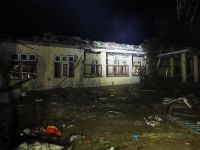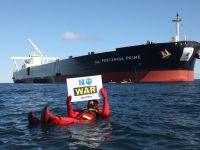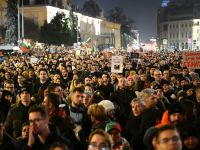Iraq is important to world energy markets because it holds more than 112 billion barrels of oil - the world's second largest reserves. Iraq also contains 110 trillion cubic feet of gas. In addition, Iraq is a focal point for regional security issues.
Note: The information contained in this report is the best available as of December 1999 and can change.
GENERAL BACKGROUND
Iraqi officials repeatedly have stated their hopes that U.N. Resolution 986 will lead to a complete lifting of U.N. sanctions imposed on the country in 1990 and 1991, following Iraq's invasion of Kuwait.
The position of the U.N. Security Council, however, has been that sanctions will continue until Iraq complies fully with a number of resolutions. U.N. Resolution 687, for instance, stipulates (among other things) that Iraq destroy all of its weapons of mass destruction.
Until U.N. sanctions are lifted, Iraq will not be able to attract the foreign investment it wants or to trade freely. Paragraph 22 of Resolution 687 provides that the oil embargo be lifted once Iraq meets all U.N. conditions, including destruction of all nuclear, chemical and biological weapons.
Iraq's Gross Domestic Product (GDP) has been cut sharply since before the Iraqi invasion of Kuwait, with per-capita income (around $587 in 1999) and living standards far below pre-war levels. On the other hand, Iraq's real GDP growth in 1999 is estimated at 13 percent (with 17 percent real growth expected in 2000). In 1999, inflation was estimated at 135 percent, and unemployment was high as well. Inflation is expected to decline, to 110 percent, in 2000, and to 60 percent in 2001, while exports are expected to exceed imports by $4 billion.
In mid-September 1999, President Hussein stated that "achieving prosperity" should be Iraq's priority. President Hussein emphasized balancing the Iraqi budget, which has been running a significant deficit for years.
In other economic news, in June 1999 Iraq attempted to shore up the value of its currency, the dinar, by selling hard currency to the public at near-black-market rates and by encouraging the public to open hard-currency accounts. In July 1999, Iraq established a free-trade zone north of Mosul, in northern Iraq. In November 1999, Iraq reportedly signed three economic and trade agreements with Iran.
OIL:
Iraq contains 112 billion barrels of proven oil reserves, the second largest in the world (behind Saudi Arabia) along with roughly 215 billion barrels of probable and possible resources. Iraq's true resource potential may be understated, as deeper oil-bearing formations located mainly in the Western Desert region could yield additional resources, but have not been explored.
Iraqi oil reserves vary widely in quality, with API gravities in the 24o to 42o range. Iraq's main export crudes come from the country's two largest active fields: Rumaila and Kirkuk. The southern Rumaila field produces three streams: Basrah Regular (34o API, 2.1 percent sulfur); Basrah Medium (30o API, 2.6 percent sulfur); and Basrah Heavy (22o-24o API, 3.4 percent sulfur).
The northern Kirkuk field produces 37o API, 2 percent sulfur crude. An additional export crude, known as "Fao Blend," is heavier and more sour, with a 27o API and 2.9 percent sulfur. In September 1999, more than 50 foreign companies attended an oil and gas technology exhibition in Baghdad, the first such gathering in 10 years. Most of the firms were from the Canada, France, Italy, and the United Kingdom. No U.S. firms attended, although a high-level Iraqi oil official has stated that Iraq is ready to deal with U.S. oil companies.
Production:
Prior to its invasion of Kuwait in August 1990, Iraqi oil production had just recovered from the costly Iran-Iraq War. By July 1990, Iraqi crude oil output had reached 3.5 MMBD, with production capacity at 4.5 MMBD -- the highest levels since 1979.
Following Iraq's invasion of Kuwait and the embargo on Iraqi oil exports, though, oil production fell to around 300,000 bbl/d. Through the first nine months of 1999, Iraqi crude oil production was averaging 2.6 MMBD, up from 1.2 MMBD in 1997 (in October 1999, production reached approximately 2.8-2.9 MMBD).
About 450,000-500,000 bbl/d of Iraq's oil output is consumed domestically, either for refining or for direct burning by industrial customers or utilities. Another 70,000-90,000 bbl/d is trucked to Jordan under a special U.N. exemption to sanctions. In late November 1999, Iraq reportedly cut oil production to only 700,000 bbl/d due to a decision to stop oil exports in protest of a U.N.
Security Council resolution authorizing only a two-week extension of the "oil-for-food" program. As of October 1999, around 1.6 MMBD of Iraqi oil production appeared to be coming from southern fields (mainly North and South Rumaila) , with an additional 1.26 MMBD from northern fields.
Iraq's battle with "water cut" reportedly was impeding progress, especially in the south. In October 1999, oil consulting firm Saybolt International reported that Iraq has been able to increase its oil production through use of short-term techniques not generally considered acceptable in the oil industry.
Exports
U.N. Resolution 986 (originally passed in April 1995) allows Iraq to sell specified dollar amounts of crude oil over six-month periods. Much of the revenue from these sales is allocated for the purchase of humanitarian supplies for distribution in Iraq under U.N. supervision.
Remaining proceeds are used to pay compensation for Gulf War victims, pipeline transit fees for Turkey, and funding for the U.N. special commission (UNSCOM) that is attempting to dismantle Iraq's capability to produce weapons of mass destruction. On February 20, 1998, the U.N. Security Council voted unanimously (Resolution 1153) to more than double (to $5.26 billion) the amount of oil Iraq can sell over six month periods.
Since then, Iraq has increased its oil exports, and in October 1999 exceeded the $5.26 billion limit (ultimately reaching $7.4 billion in sales during the sixth phase of the oil-for-food program which ended on November 20, 1999). On October 4, 1999, the UN Security Council raised the revenue cap to $8.3 billion. The Security Council also approved a two-week extension of the "oil-for-food" program on November 19, 1999.
For the first nine months of 1999, Iraq averaged crude oil production of around 2.65 MMBD, and net oil exports of around 2.1 MMBD. Besides the 70,000-90,000 bbl/d of this going to Jordan and the 450,000-500,000 bbl/d or so consumed domestically, the rest was exported either through the Iraq-Turkey pipeline or the Persian Gulf port of Mina al-Bakr.
Although U.N. Resolution 986 mandates that at least half of the "oil-for-food" exports must transit through Turkey, it appears that in recent months more Iraqi oil has been exported via Mina al-Bakr. The volume of Iraqi oil exports has increased in 1999, with exports in October 1999 running close to 2.4 MMBD.
Around 40 percent of Iraqi oil in during the six-month phase of the U.N. oil-for-food deal which ended on November 24 was sold initially to Russian firms. Other large purchasers included French and Chinese companies. Oil was then resold to a variety of oil companies, including U.S.-based.
In October 1999, U.N. Secretary General Kofi Annan endorsed Iraq's request to double its spending cap for oil sector spare parts and equipment. under Resolution 1175 of June 20, 1998) for Iraq to spend up to $300 million repairing oil facilities As of late October 1999, a total of only 15 spare parts contracts (worth around $30 million) had been approved by the U.N. sanctions committee under the sixth phase of the "oil-for-food" program.
The United States has said that the $300 million should be used only for short-term improvements to the Iraqi oil industry, and not to make long-term repairs.
The United Nations has authorized Iraqi export of oil to Jordan as an exception to the general embargo on Iraqi oil exports. Iraq exports around 70,000-90,000 bbl/d of crude oil and refined products to Jordan. Iraq uses revenues from these sales to buy Jordanian goods and services and to settle outstanding Iraqi
debts to Jordan.
In August 1998, Iraq and Jordan signed an agreement for construction of a 100,000-bbl/d pipeline to pump Iraqi crude to the Jordanian refinery at Zarqa instead of transporting the oil via truck. The pipeline could cost $2 billion.
On December 2, 1999, Jordanian and Iraqi energy ministers failed to reach agreement on a new price formula for Iraqi oil exports to Jordan. Currently, Jordan pays a maximum of $13.50 per barrel, well below the current world oil price, for oil from Iraq (its only source for oil imports).
In addition to U.N.-sanctioned oil exports to Jordan, there have been periodic reports that Iraq has smuggled up to 100,000 bbl/d of crude oil and products via a number of routes. These include: to Turkey via truck, to India and Pakistan along the Gulf coast from Jebel Ali, to Iran across the Fao Peninsula with barges, and to Dubai with the use of small tankers sailing from Umm Qasr.
Press reports also have estimated that these illegal shipments may have provided Iraq with as much as $700 million a year in revenues. It is unclear at present (December 1999) to what extent, if at all, Iraqi oil smuggling continues, although there are reports of smuggling by truck to Turkey and to the southern Persian Gulf. In August 1999, Iraq announced that is would pump $10 million worth of free oil to Turkey to aid victims of a major Turkish earthquake.
Oil Field Development, War, and Current Status:
Iraq's southern oil industry was decimated in the Gulf War, with capacity falling from 2.25 million bbl/d to 75,000 bbl/d in mid-1991. The largest producing oil field in this region is Rumaila.
The Gulf War resulted in destruction of production infrastructure (gathering centers, compression/degassing stations) at Rumaila, storage facilities, the 1.6-MMBD (pre-war capacity) Mina al-Bakr export terminal, and pumping stations along the 1.4-MMBD (pre-war capacity) Iraqi Strategic Pipeline. SOC has 7 other sizable fields which remain damaged or partially mothballed. These include Zubair, Luhais, Suba, Buzurgan, Abu Ghirab, and Fauqi.
The Kirkuk field, originally brought online by IPC in 1934, still forms the basis for northern Iraqi oil production. Kirkuk has over 10 billion barrels of remaining proven oil reserves. The Jambur, Bai Hassan, and Khabbaz fields are the only other currently- producing oil fields in northern Iraq.
While Iraq's northern oil industry remained relatively unscathed during the Iran-Iraq War, an estimated 60 percent of Northern Oil Company's (NOC) facilities in northern and central Iraq were damaged in the Gulf War. Also, post-1991 fighting between Kurdish and Iraqi forces in northern Iraq resulted in temporary sabotage of the Kirkuk field's facilities.
In 1999, production at Kirkuk was estimated at 900,000 bbl/d, with output from all northern fields around 1.26 million bbl/d. In early December 1999, Russian energy company Zarubezhneft said that it was drilling multiple wells in Iraq's Kirkuk oil field, and that this did not violate U.N. sanctions (Russian officials have denied that any work was being done).
Zarubezhneft hopes to boost Kirkuk production capacity from its current 900,000 bbl/d to around 1.1 MMBD. Zarubezhneft also has a contract to drill approximately 100 wells in the North Rumaila field.
In late October 1998, Iraq's Oil Minister Amir Mohammed Rashid said that Iraq had lowered its crude quality in order to boost sales and revenues. To accomplish this, Iraq had decided to mix superior quality Kirkuk oil with lower-quality, higher-sulfur crude from other fields.
This resulted in a lowering in the quality of Kirkuk oil, to an estimated API gravity of around 34o-35o, down from the normal 36o API and sulfur content of 2 percent (up from 1.7 percent previously).
Iraq also reportedly had pushed production at Kirkuk to levels higher than are considered proper by reservoir engineers. As of late 1999, however, many of these problems appeared to have been resolved, with the arrival of millions of dollars worth of spare parts.
With Total's technical assistance, the 11-billion barrel East Baghdad field came online April 1989 following the Iran-Iraq War. This centrally-located field currently produces 50,000 bbl/d of heavy, 23o API oil as well as 30 million cubic feet per day (Mmcf/d) of associated natural gas.
Iraq hopes to add additional facilities to boost output to over 150,000 bbl/d. In April 1994, the long-postponed Saddam field development was completed, although there are conflicting reports as to whether the field is currently online.
Saddam contains 3 billion barrels of oil and 5 trillion cubic feet (Tcf) of associated gas. Iraq is seeking foreign assistance for a second-phase Saddam development, which would raise oil production capacity from 25,000 bbl/d at present to 50,000 bbl/d, as well as 300 Mmcf/d of gas.
The Post-U.N. Sanctions Development Plan:
In May 1997, Faleh al-Khayat, Director General for Planning at the Iraqi Oil Ministry, was quoted in the trade press as stating that 3 MMBD of production capacity could be reached within 1 year, 3.5 MMBD within 3-5 years, and 6 MMBD in less than a decade after the lifting of U.N. sanctions.
This would be accomplished by a 3-phased development effort including: 1) re-working and upgrading existing upstream and downstream facilities; 2) attracting foreign investment for new field development and production; and 3) actively conducting exploration and development activities in prospective areas such as the Western Desert.
Field development work under the three phases would be extensive, with 33 fields containing 50 billion barrels of reserves and a potential production capability of 4.65 MMBD slated for eventual development. Of these 33 fields, twenty-five have been appraised, but never developed.
Of the 25 appraised fields, eleven are located in southern Iraq and have an output potential of 3 MMBD. Smaller, undeveloped fields are located in northern and central Iraq and have estimated output capabilities of 450,000 bbl/d and 300,000 bbl/d, respectively.
A further eight of the 33 fields are already in production, but will require more work to tap additional reservoirs and to bring another 900,000 bbl/d of production online.
Although development costs in Iraq are as low as $1/barrel, there is no doubt that any post-sanction oil program will require massive amounts of foreign investment.
In May 1997, former Iraqi Oil Minister Fadhil al-Chalabi estimated that Iraq would need at least $5 billion of foreign investment during the first 2-3 post-sanction years in order to bring the country's oil output back to pre-Gulf War levels. He also projected that $30-$50 billion of foreign investment would be required to bring capacity up to 6 MMBD.
As of November 1999, Iraq reportedly had signed a number of multi-billion dollar deals with foreign oil companies, mainly from China, France, and Russia (others, including several U.S. firms, also reportedly have held discussions). Iraq plans to offer new fields to foreign oil companies through production sharing contracts (PSC), joint ventures, and service contracts.
Initially, Iraq plans to offer up to 25 new fields to foreign companies. Ten of these fields, with a production potential of 2.7 MMBD, are slated for development under PSCs with foreign companies. Four of these fields are located in southern Iraq and, with a combined production potential of 2.1 MMBD, represent the cornerstone of Iraq's post-sanction development plans.
These four "giant" southern fields are Majnoon, West Qurna, Nahr Umar, and Halfaya.
As of November 1999, Iraq had signed PSCs (reportedly on relatively generous terms) for a handful of post-sanction field developments. Iraq also reportedly has placed about 30 oil fields, with more than 70 billion barrels in reserves, on offer. One deal is with the China National Petroleum Corporation (CNPC) and Chinese state-owned Norinco for development of the al-Ahdab field, located about 40 miles south of al-Kut in central Iraq.
Al-Ahdab contains an estimated 1.4 billion barrels of oil, with production potential of roughly 90,000 bbl/d. CNPC and Norinco reportedly have formed a new company, named al-Waha, to undertake the field development. Development and operating costs are expected to be around $1.3 billion. U.N. sanctions have, to date, apparently limited CNPC to primarily surveying work on al-Ahdab.
Russia, which is owed several billions of dollars by Iraq for past arms deliveries, has a $3.5 billion, 23-year deal with Iraq to rehabilitate Iraqi oilfields, particularly the 15-billion-barrel West Qurna field (located west of Basra near the Rumaila field).
Production is to begin once U.N. sanctions are lifted. Since a deal was signed in March 1997, Russia's Lukoil (the operator, heading a Russian consortium plus an Iraqi company to be selected by the Iraqi government) has prepared a plan to install equipment with capacity to produce 100,000 bbl/d from West Qurna's Mishrif formation -- possibly by March 2000.
In October 1999, Russian officials reportedly said that Iraq had accepted a Russian request to delay work on West Qurna given the continuation of U.N. sanctions. This followed an Iraqi warning that Lukoil could lose its contract at West Qurna if it did not begin work immediately. Lukoil has been hampered by sanctions in conducting needed 3D seismic or drilling work at West Qurna. The West Qurna PSC is to include development of the Yamamah and deeper Mishrif reservoirs, which, combined, contain 7-8 billion barrels of light (37o API) and heavy (27o API ) crude oil, respectively.
West Qurna has estimated production potential of 500,000-750,000 bbl/d, two-thirds of which will be heavier Mishrif crude. At present, most of the required production wells have been drilled, although a crude pipeline spur and associated gas processing stations are only partially completed. Completion of first phase development could take up to a year, but it is unclear exactly how much surface work remains.
Besides West Qurna, PSCs for the three other large southern oil fields are in various stages of negotiation. The largest of the fields is Majnoon, with reserves of 10-30 billion barrels of 28o-35o API oil. Located 30 miles north of Basrah on the Iranian border, Majnoon originally was discovered and partially appraised by Braspetro in the late 1970s.
Prior to the Iran-Iraq War, 24 wells had been drilled to assess the field's 14 oil-bearing zones. Since that time, Iraq has conducted limited reservoir and design studies. French companies Elf Aquitaine and Total reportedly have negotiated with Iraq on development rights for Majnoon. In the past, it was reported that Elf would retain operatorship and a 40 percent stake in the $3-$4 billion project.
Initial output at Majnoon is expected to be 300,000 bbl/d, with later development yielding 600,000 bbl/d or more. Ultimate production potential is estimated at up to 2 MMBD. As of September 1999, Elf and Total reportedly needed only "the stroke of the pen" to complete deals on Majnoon and the 6-billion barrel Nahr Umar field. However, in December 1999, Iraq threatened that the two companies would lose their "preferential treatment" if France did not provide sufficient support to Iraq on the U.N. Security Council.
As with Majnoon, Nahr Umar field was explored and appraised by Braspetro in the mid- to late 1970s. Prior to the Iran-Iraq War, five wells had been drilled. France-based Total apparently has all but agreed with Iraq on development of Nahr Umar.
Initial output from Nahr Umar is expected to be around 440,000 bbl/d of 42o API crude, but may reach 500,000 bbl/d with more extensive development.
The 5-billion barrel Halfaya project is the final large field development in southern Iraq. Italian Agip originally drilled four appraisal wells at Halfaya under a service contract in the 1970s. A variety of companies reportedly have shown interest in the field, which could ultimately yield 200,000-300,000 bbl/d in output.
Smaller fields with under 2 billion barrels in reserves also are receiving interest from foreign oil companies. These fields, along with anticipated maximum production levels, include: Nasiriya (250,000 bbl/d); Khormala (100,000 bbl/d); Hamrin (80,000 bbl/d); and Gharraf (100,000 bbl/d). Italy's Agip and Spain's Repsol appear to be strong possibilities to develop Nasiriya.
In addition to the 25 new field projects, Iraq plans to offer foreign oil companies service contracts to apply technology to 8 already-producing fields. This will include new reservoir development at the North and South Rumaila, Zubair, Luhais, Subba, Abu Ghirab, Buzurgan, and Fuqa fields.
Iraq also will provide incentives to promote exploration in the remote Western Desert. Located near the Saudi and Jordanian borders, Iraq has identified at least 110 prospects from previous seismic work in this region.
Source: United States Energy Information Administration
© 2000 Mena Report (www.menareport.com)







